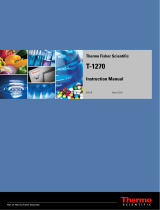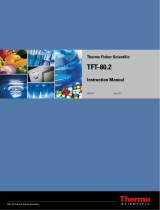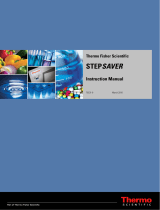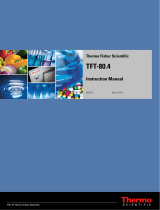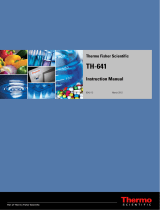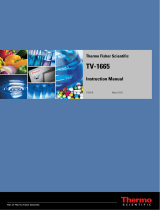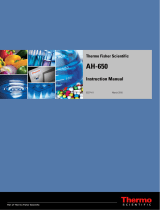Page is loading ...

11512-6 March 2010
Thermo Fisher Scientific
TFT-45.6
Instruction Manual

© 2009 Thermo Fisher Scientific Inc. All rights reserved.
ULTRACRIMP< is either a registered trademark or a trademark of Thermo Fisher Scientific.
All other trademarks are the property of Thermo Fisher Scientific Inc. and its subsidiaries.
Thermo Fisher Scientific Inc. provides this document to its customers with a product purchase to use in the
product operation. This document is copyright protected and any reproduction of the whole or any part of this
document is strictly prohibited, except with the written authorization of Thermo Fisher Scientific Inc.
The contents of this document are subject to change without notice. All technical information in this
document is for reference purposes only. System configurations and specifications in this document supersede
all previous information received by the purchaser.
Thermo Fisher Scientific Inc. makes no representations that this document is complete, accurate or error-
free and assumes no responsibility and will not be liable for any errors, omissions, damage or loss that might
result from any use of this document, even if the information in the document is followed properly.
This document is not part of any sales contract between Thermo Fisher Scientific Inc. and a purchaser. This
document shall in no way govern or modify any Terms and Conditions of Sale, which Terms and Conditions of
Sale shall govern all conflicting information between the two documents.
Release history: 11512-6 printed in March 2010.
For Research Use Only. Not for use in diagnostic procedures.

Thermo Scientific TFT-45.6 i
T
Thermo Scientific TFT-45.6 Titanium Fixed-Angle Ultraspeed Centrifuge Rotor ......... ii
Important Safety Information ................................................................................................. iii
Chapter 1 DESCRIPTION ........................................................................................................................ 1-1
Rotor Description .................................................................................................... 1-2
Rotor Specifications ................................................................................................. 1-2
Accessories ............................................................................................................... 1-3
Chapter 2 OPERATION ............................................................................................................................ 2-1
Prerun Safety Checks ............................................................................................... 2-2
Chemical Compatibility .......................................................................................... 2-2
Compartment Loads in Excess of Design Mass ........................................................ 2-3
Critical Speed .......................................................................................................... 2-3
Rotor Precool .......................................................................................................... 2-3
Relative Centrifugal Force (RCF) Determination .................................................... 2-3
Calculation of Sedimentation Time in Aqueous (Non-gradient) Solutions .............. 2-4
Rotor Balancing ....................................................................................................... 2-5
Chemical Compatibility .......................................................................................... 2-6
Rotor Loading and Sealing ....................................................................................... 2-9
Ultracentrifuge / Rotor Log Book .......................................................................... 2-14
Chapter 3 CARE and MAINTENANCE ................................................................................................... 3-1
Corrosion ................................................................................................................ 3-2
Cleaning and Decontamination ............................................................................... 3-2
Storage ..................................................................................................................... 3-5
Service Decontamination Policy .............................................................................. 3-5
Chemical Compatibility Chart ...............................................................................A-1
Contact Information ................................................................................................B-1
Table of contents

Thermo Scientific TFT-45.6 ii
P
This manual is a guide for the use of
Thermo Scientific TFT-45.6 Titanium Fixed-Angle
Ultraspeed Centrifuge Rotor
Data herein has been verified and is believed adequate for the intended use of the rotor. Because failure
to follow the recommendations set forth in this manual could produce personal injury or property
damage, always follow the recommendations set forth herein. Thermo Fisher Scientific does not
guarantee results and assumes no obligation for the performance of rotors or other products that are
not used in accordance with the instructions provided. This publication is not a license to operate
under, nor a recommendation to infringe upon, any process patents.
Publications prior to the Issue Date of this manual may contain data in apparent conflict with that
provided herein. Please consider all data in this manual to be the most current.
NOTES, CAUTIONS, and WARNINGS within the text of this manual are used to emphasize
important and critical instructions.
WARNING informs the operator of a hazard or unsafe practice that could result in personal injury,
affect the operator's health, or contaminate the environment.
CAUTION informs the operator of an unsafe practice that could result in damage of equipment.
NOTE highlights essential information.
© 1982, 2000, 2010 by Thermo Fisher Scientific
CAUTION and WARNING are accompanied by a hazard symbol and appear near the
information they correspond to.

Preface
iii TFT-45.6 Thermo Scientific
Important Safety Information
Certain potentially dangerous conditions are inherent to the use of all centrifuge rotors. To ensure safe
operation of this rotor, anyone using it should be aware of all safe practices and take all precautions
described below and throughout this manual.
WARNING
When using radioactive, toxic, or pathogenic materials, be aware of all characteristics of
the materials and the hazards associated with them in the event leakage occurs during
centrifugation. In the event of a rotor failure, neither the centrifuge nor the rotor can
protect you from particles dispersed in the air. To protect yourself, we recommend
additional precautions be taken to prevent exposure to these materials, for example, use of
controlled ventilation or isolation areas.
Always be aware of the possibility of contamination when using radioactive, toxic, or
pathogenic materials. Take all necessary precautions and use appropriate decontamination
procedures if exposure occurs.
Never use any material capable of producing flammable or explosive vapors or creating
extreme exothermic reactions.
Never exceed the maximum rated speed of the installed rotor; to do so can cause rotor
failure.
Always reduce (derate) rotor speed as instructed in this manual whenever:
•the rotor speed/temperature combination exceeds the solubility of the gradient
material and causes it to precipitate.
•the compartment load exceeds the maximum allowable compartment load specified.
See Chapter 2, Operation.
Failuer to reduce rotor speed under these conditions can cause rotor failure

Preface
Thermo Scientific TFT-45.6 iv
CAUTION
Do not expose aluminum rotor components to: strong acids, bases, or alkaline laboratory
detergents; liquid chlorine bleach; or salts (chlorides) of heavy metals such as cesium, lead,
silver, or mercury. Use of these materials with aluminum can cause a chemical reaction that
initiates corrosion.
Do not operate or precool a rotor at the critical speed, as this will have a detrimental effect
on centrifuge component life. See Chapter 2, Operation.
Do not operate the rotor unless it is symmetrically balanced as described in this manual.
Operating the rotor out of balance can cause damage to the centrifuge drive assembly.
Do not operate the rotor without the cover in position and locked in place and the rotor
locked to the centrifuge drive. See Chapter 2, Operation.
Always maintain the rotor in the recommended manner. The rotor and all accessories
should be clean and inspected prior to each run; do not use rotors showing signs of
corrosion or cracking. See Chapter 3, Care and Maintenance.
Do not autoclave or expose any aluminum rotor body and cover or expose any aluminum
rotor parts to temperatures in excess of 100°C.

Thermo Scientific TFT-45.6 1-1
1
DESCRIPTION
This manual provides you with the information you will need to operate and maintain your Thermo
Scientific TFT-45.6 Fixed-Angle Ultraspeed Centrifuge Rotor. If you encounter any problem
concerning either operation or maintenance that is not covered in the manual, contact Thermo Fisher
Scientific for assistance. In the United States, telephone toll free 1-866-9THERMO. Outside the
United States, contact your distributor or agent for Thermo Fisher Scientific products. Thermo Fisher
Scientific product information is available on our internet web site at http://
www.thermo.com/centrifuge .
Contents
•“Rotor Description” on page 1-2
•“Rotor Specifications” on page 1-2
•“Accessories” on page 1-3

1 DESCRIPTION
Rotor Description
1-2 TFT-45.6 Thermo Scientific
Rotor Description
The TFT-45.6 is a forty-place, fixed-angle, ultracentrifuge rotor that can be used at speeds up to 45
000 rpm.1 The rotor body is made from a titanium forging for strength and corrosion resistance. The
aluminum lid and locking nut are given a green anodized finish for surface protection. The rotor is
tightly sealed during operation by two O-rings, one that fits inside the rotor lid and another around
the bottom of the locking nut. The forty tube compartments are bored at a 20° angle to the axis of
rotation. A disc with alternative black and reflective segments attached to the bottom of the rotor
provides overspeed protection.
Rotor Specifications
1Speed in revolutions per minute (rpm) is related to angular velocity, w, according to the following:
Where w = rad/s. All further references in this manual to speed will be designated as rpm.
ω(rpm)=2π
60
------
⎝⎠
⎛⎞ rpm()0.10472()=
Table 1-1.Rotor Specifications
Rotor Type Fixed Angle
Maximum Speed (rpm)*
*With tubes filled with a non-precipitating homogenous solution having an average density of 1.2 g/ml or less.
45 000*
Relative Centrifugal Force (RCF) at Max. Speed
- at rmaximum (outer row)10.56 cm 238 859
- at raverage (outer row) 9.08 cm 205 383
- at rminimum (outer row) 7.60 cm 171 906
at rmaximum (inner row) 9.03 cm 204 252
- at raverage (inner row) 7.55 cm 170 775
- at rminimum (inner row) 6.07 cm 137 299
K Factor at Maximum Speed
- outer row 41.1
- inner row 19.6
Critical Speed 1150 rpm
Tube Size (Maximum) 13 mm x 66mm
Number of Tube Compartments 40
Capacity per Compartment (Nominal) 6.0 ml
Total Rotor Capacity (Nominal) 240 ml
Maximum Tube Compartment Mass 12.3 grams
Compartment Angle 20°
Rotor Diameter 22.4 cm (8.81 in)
Rotor Weight (empty) 10.91 kg (24.0 lbs)

1 DESCRIPTION
Accessories
Thermo Scientific TFT-45.6 1-3
Accessories
Accessories Supplied
The accessories supplied with the TFT-45.6 Rotor, Catalog No. 54300 (rotor with complete
accessories), are listed in Table 1-2. Those items indicated by an asterisk (*) are not supplied with
Catalog No. 08322, which is a T-647.5 with basic accessories only.
To order replacement accessories, telephone 1-866-9THERMO in the United States. Outside the
United States, contact the local representative, distributor or agent for Thermo Fisher Scientific
products. Be sure to provide a description of the part, the catalog number, plus the rotor model and
serial number.
Optional Sealing Assembly
If you prefer, you can use the TFT-45.6 Rotor with thinwall polyallomer tubes and five-piece
aluminum sealing cap assemblies that consist of: a tube plug, an O-ring, a tube plug cover, a sealing
nut, and a post-fill screw. You must purchase all items separately: the TFT- 45.6 Rotor with basic
accessories only, Catalog No. 11637; a Tool Kit, Catalog No. 11537; the tubes, and the sealing
assemblies. Table 1-2 lists the catalog number and description of the tubes and sealing assemblies
required, and Table 1-3 lists the parts supplied in the Tool Kit. You need not purchase the kit if you
have the tools listed. Also, any of the tool listed can be ordered separately by the catalog number given
in the table.
Note In order to seal the ULTRACRIMP< Tubes, (supplied with Catalog No. 54304) you must
have an ULTRACRIMP® Sealing Tool, Catalog No. 03920.
Table 1-2. Accessories Supplied
Qty. Catalog No. Description
1 51942 Rotor Stand
1 65937 Vacuum Grease
1 64172 Lubricant
4 03945*
*Not supplied with Catalog No. 08322 (basic accessories only).
ULTRACRIMP® tues, 6.0 ml (pkg/50)**
**Each package of tubes is supplied with an equivalent number of tube caps and tube plugs.
40 03992*Rotor Caps
1 03921*Tube Racks, 4-place (1 pair)
1 51351 Overspeed Decal, 45 000 rpm (extra)
1 11547 O-ring, Rotor Cover, Viton® (extra)
1 11551 O-ring, Locking Nut, Rotor Cover Assembly, Viton® (extra)
1 52384 Rotor Log Book
1 11512 Instruction Manual

1 DESCRIPTION
Accessories
1-4 TFT-45.6 Thermo Scientific
Table 1-3.Optional Multipiece Sealing Assembly Components
Catalog No. Description
03958 Tubes, 6.5 ml, Polyallomer (pkg/50)
03948 Sealing Cap Assembly (40 each)
Table 1-4.Tool Kit (Catalog No. 52988) for use with Optional Sealing Assembly
Catalog No. Description
52176 Tube Cap Vise
11538 Tube Removal Tool (for Catalog No. 03140)
52881 Torque Wrench
52882 Socket, (7/16 inch)
11540 Socket (3/4 inch)

Thermo Scientific TFT-45.6 2-1
2
OPERATION
This chapter contains the information necessary to prepare the TFT-45.6 Rotor for operation and
includes important safety information.
Contents
•“Prerun Safety Checks” on page 2-2
•“Chemical Compatibility” on page 2-2
•“Compartment Loads in Excess of Design Mass” on page 2-3
•“Critical Speed” on page 2-3
•“Rotor Precool” on page 2-3
•“Relative Centrifugal Force (RCF) Determination” on page 2-3
•“Calculation of Sedimentation Time in Aqueous (Non-gradient) Solutions” on page 2-4
•“Rotor Balancing” on page 2-5
•“Rotor Loading and Sealing” on page 2-9
•“Ultracentrifuge / Rotor Log Book” on page 2-14

2 OPERATION
Prerun Safety Checks
2-2 TFT-45.6 Thermo Scientific
Prerun Safety Checks
To ensure safe performance of the rotor, before every run you should:
•read the Safety Information Page in the front of this manual.
•make sure each tube compartment is clean and that there is no sign of corrosion.
•be sure the rotor itself is clean and shows no sign of corrosion or cracking. Also, make sure there
are no scratches or burrs around the rim of the rotor.
•check the centrifuge chamber and drive spindle to be sure they are clean and free of scratches and
burrs.
•verify that proper overspeed decal is firmly attached to bottom of rotor; decal should have 20
black segments.
•check the chemical compatibility of all materials used (see Appendix A).
•inspect the rotor cover O-rings for cracks, tears, or abrasions; replace if necessary. Be sure the
O-rings are properly lubricated.
•make sure the rotor cover is on and properly tightened and that the rotor cover tool has been
removed from the locking nut.
•be sure the proper environment has been selected for operation; for example, controlled
ventilation or isolation, if required.
•check the top speed capability of the tube (or bottle) being used; observe the CAUTION.
Chemical Compatibility
The critical components of the TFT-45.6 Rotor apt to come in contact with solution are: rotor body
(titanium), rotor cover assembly (aluminum), rotor cap and tube cap (aluminum), tube plugs (Buna
N), O-rings (Viton䉸) and the material of the tubes being used.
The chemical compatibility of rotor elements and accessory materials is given in the Appendix.
Because no organized chemical resistance data exists for materials under the stress of centrifugation,
this data is intended to be used only as a guide to the selection of tube materials. When in doubt, we
recommend pretesting of sample lots.
WARNING The stresses that this rotor withstands during centrifugation eventually cause
the rotor body to weaken, increasing the possibility of rotor failure. For your safety, we
recommend that this rotor be withdrawn from service after it has been used for 5 000 runs
or 10 000 hours, whichever comes first. Failure to do so can cause rotor failure with
subsequent sample loss and damage to the rotor and/or centrifuge. If the material being
processed is hazardous, the loss of sample can result in personal injury.
CAUTION When using tubes or bottles other than those supplied by Thermo Fisher
Scientific, be sure to check the top speed capability; when in doubt, do a test run for the
desired application. If using a Thermo Fisher Scientific tube (or bottle) assembly other
than those supplied with the rotor, refer to the Product Guide for the maximum speed.
Exceeding the top speed capability of the tube (or bottle) can result in its breakage.

2 OPERATION
Compartment Loads in Excess of Design Mass
Thermo Scientific TFT-45.6 2-3
Compartment Loads in Excess of Design Mass
A recommended design mass has been established for each ultracentrifuge rotor, representing the
maximum mass that each tube compartment can contain during operation. To prevent rotor failure,
the total contents, including specimen, tube, rotor cap, tube cap, and tube plug, should not exceed the
figure given unless rotor speed is reduced proportionately. (If using the optional multipiece sealing
assembly, include the weight of the complete assembly.)
Strict adherence to the maximum allowable compartment mass or reduced speed is required to prevent
rotor failure. Observe the WARNING.
The design mass for each compartment of the TFT-45.6 Rotor is 12.3 g at 45 000 rpm. This figure is
based on the use of a thinwall polyallomer tube filled with a liquid at 1.2 specific gravity, plus all sealing
assembly components.
If the compartment mass is greater than 12.3 g, use the following formula to determine the reduced
speed:
Critical Speed
The critical speed is that speed at which any rotor imbalance will produce a driving frequency equal to
the resonant frequency of the rotating system (that is, the rotor and the centrifuge drive). At this speed,
the rotor may produce large amplitude vibrations which can be felt in the centrifuge frame. Mass
imbalance will contribute to increased vibration intensity at critical speed. Avoid operating the rotor at
the critical speed, which is approximately 1150 rpm. Operation at the critical speed will have a
detrimental effect on centrifuge component life.
Rotor Precool
If samples are routinely processed around 4°C or below, the rotor should be stored in a refrigerator or a
cold room. If this is not possible, the rotor can be precooled in a Thermo Scientific OTD
Ultracentrifuge. Refer to the ultracentrifuge instruction manual for precooling directions. Be careful
not to precool the rotor at its critical speed, which is approximately 1150 rpm.
Relative Centrifugal Force (RCF) Determination
Relative centrifugal force (RCF) refers to the force during centrifugation that moves the particulate
outward from the center of rotation. This force is proportional to the radial distance and the square of
the rotor speed. The RCF value, also known as g force, is determined by the following formula:
WARNING Always reduce (derate) rotor speed as instructed in this manual whenever the
compartment load exceeds the maximum allowable compartment load specified. Failure to
reduce rotor speed under these conditions can cause rotor failure.
Reduced Speed 45 000 12.3 g
actual weight (g)
--------------------------------------=
RCF 11.17(r)=rpm
1000
------------
⎝⎠
⎛⎞
2

2 OPERATION
Calculation of Sedimentation Time in Aqueous (Non-gradient) Solutions
2-4 TFT-45.6 Thermo Scientific
when r = the radius in centimeters from the centerline of the rotor to the point in the tube where
RCF value is required
and rpm = the rotor speed in revolutions per minute
Figure 2-1 shows the minimum, average, and maximum radii of the TFT-45.6 Rotor. Table 2-1 gives
the RCF value at each radius at speeds from 20 000 rpm to 45 000 rpm in increments of 500 rpm.
The RCF value at any other speed can be calculated by using the above RCF formula.
Figure 2-1. TFT-45.6 Rotor Radii
Calculation of Sedimentation Time in Aqueous (Non-gradient)
Solutions
The time required to sediment a particle in water at 20°C through the maximum rotor path length
(that is, the distance between rminimum and rmaximum) can be calculated using the equation:
where:
t = sedimentation time in hours
K = the clearing factor for the rotor (defined on the next page)
S20, w = the sedimentation coefficient for the particle of interest in water at 20°C as expressed
in Svedbergs1
The clearing (or K) factor is defined by the equation:
Note The radii values given are the actual rotor specifications. These values do not take the
thickness of the tube into consideration.
tK
S20,w
-------------
=

2 OPERATION
Rotor Balancing
Thermo Scientific TFT-45.6 2-5
Where rmaximum and rminimum are the maximum and minimum rotor radii, respectively, and rotor speed
is expressed in rpm.
K factors for the TFT-45.6 Rotor, at speeds from 20 000 rpm to 45 000 rpm (in increments of 500
rpm), are listed in Table 2-1.
Example: The TFT-45.6 Rotor has a K factor of 41.1 for the out row at the maximum permitted speed
(45 000 rpm). If the particles to be sedimented have a sedimentation coefficient of 10S, the
estimated run time required at maximum speed will be::
Note that the calculation assumes particles in water at 20°C. If the suspending medium is denser or more viscous than
water, the sedimentation time will be greater.
Rotor Balancing
Always balance the rotor according to the following criteria:
a. balance pairs of tubes containing fluid of identical specific gravity to within 0.1 grams and
place them in opposing tube compartments.
b. when using less than a full compliment of forty tubes, the rotor can be operated at maximum
allowable speed provided the rotor is symmetrically balanced (see figure 2-2 for examples).
c. if an odd number of samples are to be run, balance the load as above with a dummy tube that
contains a solution having the same specific gravity as the sample in the opposing tube
compartment.
1 The sedimentation coefficient (S) in seconds, for a particle in a centrifugal field is defined by the equation S =
(dx/dt) [1/(ω2x)]; where dx/dt = sedimentation velocity of the particle in cm/s; ω = rotor speed in rad/s; and x =
the distance of the particle from the axis of rotation in centimeters. Conventionally, experimentally determined
values of sedimentation coefficients are multiplied by 1013 to convert them to Svedberg units (S), so a particle
with an experimentally determined sedimentation coefficient of 10-11 seconds is usually referred to in the
literature as a "100 S particle." Since the value determined for the sedimentation coefficient is dependent on the
density and viscosity of the solution in which centrifugation is performed, values are usually reported for the
standard conditions of infinite dilution in water at 20°C, and designated S20, w.
K 253000()In rmaximum
rminimum
--------------------
⎝⎠
⎛⎞
rotor speed
1000
-------------------------
⎝⎠
⎛⎞
2
÷=
t41.1
10S
----------
=4.11 hours 4 hours, 7 minutes=
CAUTION Do not operate the rotor unless it is symmetrically balanced as described in this
manual. Operating the rotor out of balance can cause damage to the centrifuge drive
assembly.
CAUTION Compartments that do not contain a filled tube should be left empty during
operation.

2 OPERATION
2-6 TFT-45.6 Thermo Scientific
Table 2-1. TFT-45.6 Rotor: RCF Values and K Factors* Outer Row
Outer Row
Speed (rpm) rmax. 10.56 cm
RCF
ravg. 9.08 cm rmin. 7.60 cm K Factors
20 000 47 182 40 569 33 957 208
20 500 49 571 42 623 35 676 198
21 000 52 018 44 728 37 437 189
21 500 54 525 46 883 39 241 180
22 000 57 090 49 089 41 088 172
22 500 59 715 51 346 42 977 164
23 000 62 398 53 653 44 908 157
23 500 65 141 56 011 46 882 151
24 000 67 942 58 420 48 898 144
24 500 70 803 60 880 50 956 139
25 000 73 722 63 390 53 058 133
25 500 76 700 65 951 55 201 128
26 000 79 738 68 562 57 387 123
26 500 82 834 71 225 59 615 119
27 000 85 989 73 938 61 886 114
27 500 89 204 76 702 64 200 110
28 000 92 477 79 516 66 555 106
28 500 95 809 82 381 68 954 103
29 000 99 200 85 297 71 394 99.0
29 500 102 651 88 264 73 877 95.6
30 000 106 160 91 281 76 403 92.5
30 500 109 728 94 349 78 971 89.5
31 000 113 355 97 468 81 581 86.6
31 500 117 041 100 638 84 234 83.9
32 000 120 786 103 858 86 929 81.3
32 500 124 590 197 129 89 667 78.8
33 000 128 453 110 450 92 447 76.4
33 500 132 375 113 823 95 270 74.2
34 000 136 356 117 246 98 135 72.0
34 500 140 396 120 719 101 043 69.9
35 000 144 495 124 244 103 993 67.9
35 500 148 653 127 819 106 985 66.0
36 000 152 870 131 445 110 020 64.2

2 OPERATION
Thermo Scientific TFT-45.6 2-7
36 500 157 146 135 122 113 097 62.5
37 000 161 481 138 849 116 217 60.8
37 500 165 875 142 627 119 379 59.2
38 000 170 327 146 456 122 584 57.6
38 500 174 839 150 335 125 831 56.1
39 000 179 410 154 265 129 121 54.7
39 500 184 040 158 246 132 453 53.3
40 000 188 728 162 278 135 827 52.0
40 500 193 476 166 360 139 244 50.7
41 000 198 283 170 493 142 793 49.5
41 500 203 148 174 677 146 205 48.3
42 000 208 073 178 911 149 749 47.2
42 500 213 057 183 196 153 336 46.1
43 000 218 099 187 532 156 965 45.0
43 500 223 201 191 919 160 637 44.0
44 000 228 361 196 356 164 351 43.0
44 500 233 581 200 844 168 107 42.0
45 000 238 859 205 383 171 906 41.1
*RCF and K Factor are based on radii values that do not take the thickness of the tube into consideration.
Table 2-2. TFT-45.6 Rotor: RCF Values and K Factors* Inner Row
Inner Row
Speed (rpm) rmax. 10.56 cm
RCF
ravg. 9.08 cm rmin. 7.60 cm K Factors
20 000 40 346 33 733 27 121 251
20 500 42 389 35 441 28 494 239
21 000 44 482 37 191 29 901 228
21 500 46 625 38 983 31 341 217
22 000 48 819 40 817 32 816 208
22 500 51 063 42 694 34 325 198
23 000 53 358 44 612 35 867 190
23 500 55 703 46 573 37 444 182
24 000 58 098 48 576 39 054 174
24 500 60 544 50 621 40 698 167
Table 2-1. TFT-45.6 Rotor: RCF Values and K Factors* Outer Row
Outer Row
Speed (rpm) rmax. 10.56 cm
RCF
ravg. 9.08 cm rmin. 7.60 cm K Factors

2 OPERATION
2-8 TFT-45.6 Thermo Scientific
25 000 63 041 52 708 42 376 161
25 500 65 588 54 838 44 088 155
26 000 68 185 57 009 45 834 149
26 500 70 833 59 223 47 614 143
27 000 73 531 61 479 49 428 138
27 500 76 279 63 777 51 275 133
28 000 79 078 66 117 53 157 128
28 500 81 928 68 500 55 072 124
29 000 84 828 70 924 57 021 120
29 500 87 778 73 391 59 005 116
30 000 90 779 75 900 61 022 112
30 500 93 830 78 451 63 073 108
31 000 96 931 81 044 65 158 105
31 500 100 083 83 276 67 276 101
32 000 103 286 86 358 69 429 98.1
32 500 106 539 89 077 71 616 95.1
33 000 109 842 91 839 73 836 92.3
33 500 113 196 94 643 76 091 89.5
34 000 116 600 97 490 78 379 86.9
34 500 120 055 100 378 80 701 84.4
35 000 123 560 103 309 83 057 82.0
35 500 127 115 106 281 85 447 79.7
36 000 130 721 109 296 87 871 77.5
36 500 134 378 112 353 90 329 75.4
37 000 138 084 115 453 92 821 73.4
37 500 141 842 118 594 95 346 71.5
38 000 145 649 121 778 97 906 69.6
38 500 149 507 125 003 100 499 67.8
39 000 153 416 128 271 103 127 66.1
39 500 157 375 131 581 105 788 64.4
40 000 161 384 134 934 108 483 62.8
40 500 165 444 138 328 111 212 61.3
Table 2-2.TFT-45.6 Rotor: RCF Values and K Factors* Inner Row
Inner Row
Speed (rpm) rmax. 10.56 cm
RCF
ravg. 9.08 cm rmin. 7.60 cm K Factors

2 OPERATION
Rotor Loading and Sealing
Thermo Scientific TFT-45.6 2-9
Figure 2-2. Compartment Loading
Rotor Loading and Sealing
Prepare the ULTRACRIMP䉸 tubes for use by following the tube filling and tube sealing procedures
given in the ULTRACRIMP䉸 Tube Sealing System Instruction Manual.
Using ULTRACRIMP® Tubes and Sealing System
Load and seal the rotor as follows:
1. Gently place the filled ULTRACRIMP䉸 tubes into the tube compartments (balancing the rotor as
described on page 2-5, Rotor Balancing).
41 000 169 554 141 765 113 875 59.8
41 500 173 715 145 243 116 772 58.3
42 000 177 926 148 764 119 603 57.0
42 500 182 188 152 327 122 467 55.6
43 000 186 500 155 933 125 366 54.3
43 500 190 862 159 580 128 298 53.1
44 000 195 275 163 270 131 264 51.9
44 500 199 738 167 001 134 265 50.7
45 000 204 252 170 775 137 299 49.6
*RCF and K Factor are based on radii values that do not take the thickness of the tube into consideration.
Table 2-2. TFT-45.6 Rotor: RCF Values and K Factors* Inner Row
Inner Row
Speed (rpm) rmax. 10.56 cm
RCF
ravg. 9.08 cm rmin. 7.60 cm K Factors

2 OPERATION
Rotor Loading and Sealing
2-10 TFT-45.6 Thermo Scientific
2. Place a rotor cap, PN 03992 into each tube compartment that contains a filled tube. Push the
rotor cap until it is properly seated; when properly seated, the edge of the cap will be
approximately flush with the top of the outer edge of the tube compartment (see figure 2-3).
3. Check locking nut O-ring and rotor cover O-ring for scuffs, cracks or breaks. Replace if
necessary (see figure 3-1 for replacement part catalog numbers).
4. Coat O-rings lightly with vacuum grease, PN 65937.
5. Check that the locking nut thread is lightly lubricated with grease, PN 64172.
6. Place the rotor cover (with O-ring) on the rotor body. Finger tighten the locking nut by turning
it clockwise. Insert the rotor handle through the locking nut and continue turning it clockwise
until the rotor cover is tightened securely. Remove the rotor handle from the locking nut.
Figure 2-3. Properly Seated Rotor Cap
7. Carry the rotor carefully and lower it into the centrifuge chamber slowly and vertically. Be sure
the rotor snaps in place on the drive adapter. Check that it is properly seated by pulling it gently
in an upward direction and noting a small amount of resistance.
Perform the centrifuge run as explained in the centrifuge instruction manual.
CAUTION Do not operate the rotor unless it is symmetrically balanced as described in this
manual. Operating the rotor out of balance can cause damage to the centrifuge drive
assembly.
CAUTION Compartments that do not contain a filled tube should be left empty during
operation.
CAUTION Rotor handle must be removed prior to centrifuge run.
/
